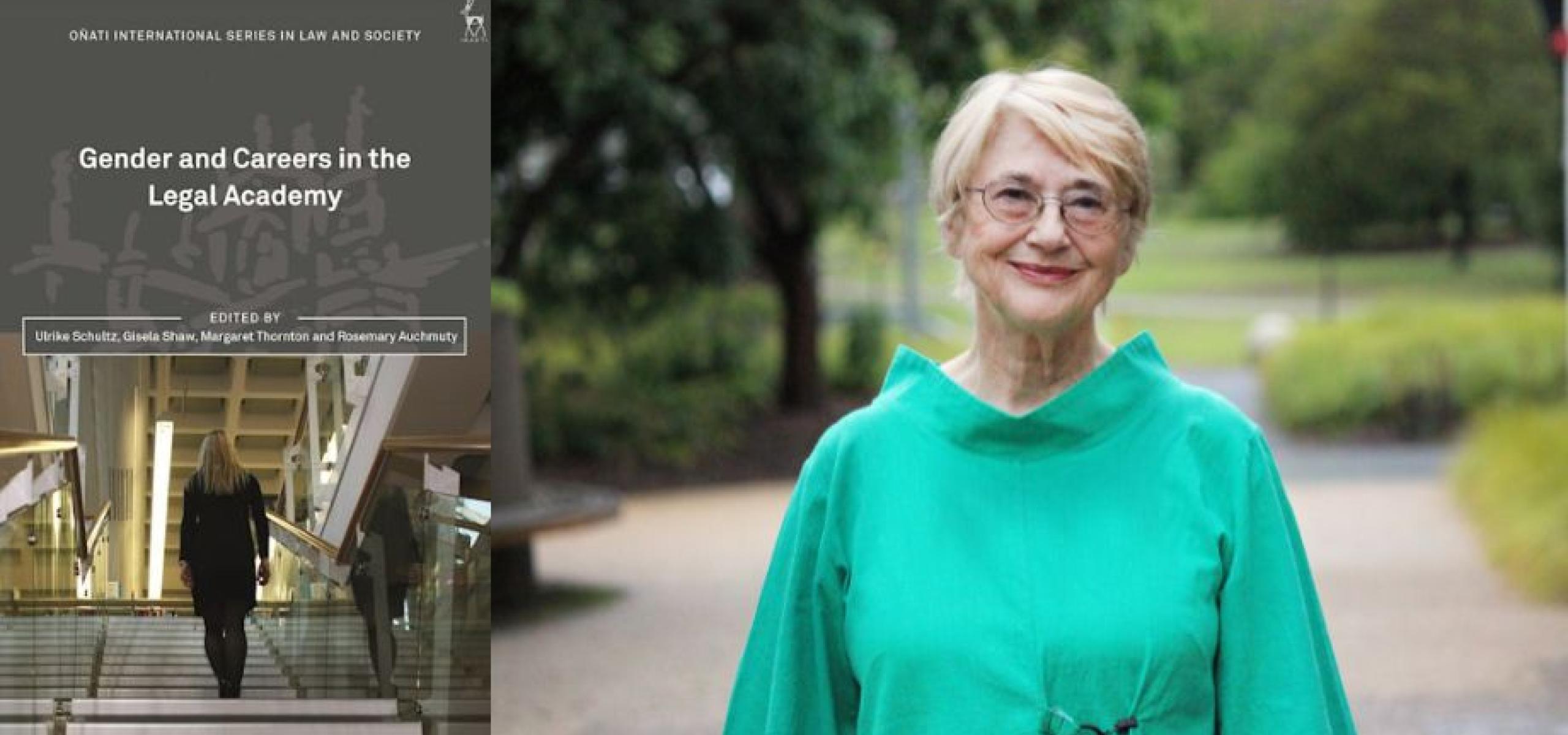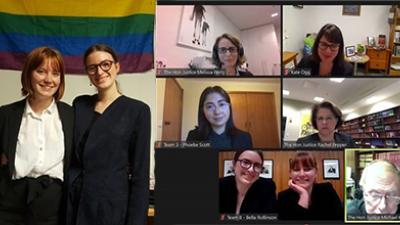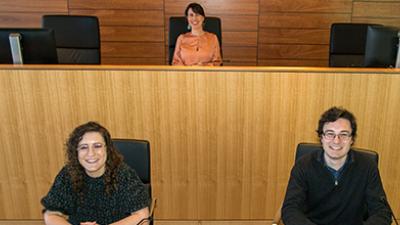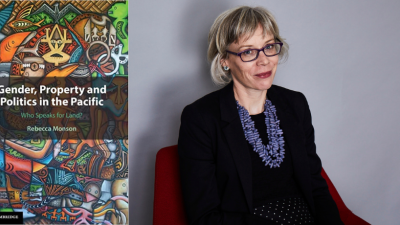
A new book co-edited by Emerita Professor Margaret Thornton FASSA FAAL sheds light on the impact women have made in legal practice and the judiciary.
…all the essays include accounts of how feminist legal scholars have overcome the antipathy towards women by virtue of their resilience and individual efforts.
The 21st century has seen an increase in international scholarship focusing on women in the judiciary and legal practice.
However, the diverse history and careers of women legal academics have remained largely overlooked until now.
Emerita Professor Margaret Thornton FASSA FAALhas co-edited a new global collection with Ulrike Schultz (Retired Senior Academic), Emeritus Professor Gisela Shaw and Professor Rosemary Auchmuty that seeks to fill this gap in the literature.
Gender and Careers in the Legal Academy (Hart Publishing, 2021; Bloomsbury, 2022) explores the careers of women academic pioneers and theoretical issues relating to culture and gender.
“The book is the first study of its kind but, as it is barely a century since women were admitted to law schools as students, this may not be surprising,” Professor Thornton said.
“Some of the essays adopt a historical perspective and focus on the struggle by women to be admitted, while others focus on the ‘firsts’ to be promoted to the professoriate or deanship; some authors adopt an autobiographical perspective, while others focus on cultural aspects, such as the role of feminisms or masculinities in the academy.”
In this Q&A, Professor Thornton explains the impact of feminism in legal academia, the experiences of women striving for equality in the legal academy and why this book is important.
To what extent has feminist perspectives been embraced in academia?
As law was for so long a masculinist prerogative, there was initially strong opposition everywhere to feminist perspectives, but the increase in the enrolment of women students compelled a change of heart. Women were no longer prepared to accept that abstract legal knowledge could be regarded as objective and unbiased when it referred only to the male subject.
Broader social currents of change were also occurring that hastened acceptance. In the 1990s, for example, the Australian Federal Government funded the preparation of ‘gender-sensitive materials’ for the Priestley 11 (the 11 compulsory subjects in the Bachelor of Laws) for distribution to all law schools.
This followed a national outcry that ensued from a remark by a SA Supreme Court judge that “a measure of rougher than usual handling” was acceptable on the part of a husband towards his wife if she were less than willing to engage in sex. In addition to the gender-sensitive materials for the Priestley 11, specialist courses, such as Gender and the Law, and Feminist Legal Theory, were established in many law schools.
What are some of the key ways that feminist teaching of law has influenced law-making?
Feminist teaching has had a significant impact on law over the last 40 or 50 years, particularly through the undertaking of original research. Multiple reforms, addressing both substance and procedure, have been effected in family law, homicide defences, domestic violence, sexual assault, anti-discrimination law, sexual harassment, dispute resolution, and many other areas.
Perspectives influenced by feminism, such as bodily autonomy, sexuality, emotion, caring for others, wellbeing and flexible work, have also been incorporated across the board, as well as in specific areas such as labour law.
What differences exist between jurisdictions around the world in regard to women in the legal academy?
The entry of women into the legal academy is one dimension of the struggle for gender equality throughout the world, although it cannot be considered apart from its unique historical and contemporary context.
For example, in what became the Czech Republic, Hitler closed down all 10 universities and the Faculty of Law building in Prague became the headquarters of the Schutzstaffel (SS), which involved a new start (Jan Kober); in contrast, the University of Buenos Aires has a staggering 28,000 law students, which necessitated a completely different approach (Maria da Gloria Bonelli).
The assignation of unpaid caregiving to women detracts from female authority at work everywhere, but the ongoing suspicion of the feminine remains markedly resistant to change in countries such as China (Xiaonan Liu).
Although all law schools had long been masculinised spaces, sometimes for hundreds of years, all the essays include accounts of how feminist legal scholars have overcome the antipathy towards women by virtue of their resilience and individual efforts.
You wrote a chapter in the book on the first and (last?) feminist law professors in Australia. How has the position of women in the legal academy evolved from then till now?
The first woman to be appointed as a law professor in Australia was Enid Campbell, who was appointed at Monash in 1967 (Kim Rubenstein). Two more were appointed over the next 20 years, including Alice Tay in 1975 (Susan Bartie), but over the successive 20 years, from 1988-2008, 20 women were appointed, 14 of whom I interviewed for the chapter.
Unlike today, none of the women aspired to become a legal academic when they embarked on a legal career, let alone a law professor, and mentoring was virtually non-existent when there were no senior women. However, once one woman had cracked the glass ceiling, others followed, and a critical mass of women made a huge difference for those who followed. The numerical feminisation of the Australian student body by the late 1980s also contributed to the creation of a more receptive environment for women.
All the interviewees loved teaching, particularly the ability to encourage students to think outside the box. They were saddened by the university’s shift to managerialism and felt that feminist knowledge for its own sake was devalued in a world where attracting grant money was regarded as more important, particularly as the lives of junior colleagues became more stressful than it had been in the 1970s, 80s and 90s.
As competition policy took over in the corporatised university, it was the professor as ‘technopreneur’ who was most valued. Ever-increasing fees (as opposed to free higher education) also meant that students were more likely to be interested in vocationalism in order to repay their HECS debt than in engaging in progressive causes, such as radicalising the university, as had once been the case.
Why is this book important?
The book is important as the issue of women in the legal academy has attracted little attention compared with issues relating to gender and judging or legal practice. The book is encyclopaedic in its (600-page) coverage, containing substantial comparative data regarding the admission of women to law schools and their individual experiences.
Rather than focus solely on more familiar Anglophone countries, the book is also diverse , with essays encompassing 19 countries, including those that are less familiar, such as Ghana (J Jarpa Dawuni), Egypt (Omnia Mehanna and Nadi Sonneveld), Kuwait (Rania Maktabi), Estonia (Merike Ristikivi) and the Philippines (Emily Sanchez Salcedo).
Each essay is discrete, some focusing on the travails of the ‘firsts’, with others focusing on institutional change in the context of the history and culture of a particular country. Comparisons might encourage one to question the practices of one’s own country, such as why higher education is still free in Germany (Ulrike Schultz) when so many others, such as Australia and India (Swethaa S Ballakrishnen and Rupali Samuel), have proceeded down the user-pays route.
How does it impact current events, debates or academic controversies?
Issues pertaining to gender and law are inescapably bound up with the contemporary legal culture. An ongoing conundrum is what is the law school for? Is it to prepare students for legal practice, expecting them to accept without question certain basic presuppositions of law, or should it be more like an arts degree? That is, should legal academics start off with the assumption that there are no right answers and that they, as well as their students, should question everything?
How does this book relate to other current projects you are working on, either solo or collaborating with colleagues?
This book relates to other work in which I am presently engaged in relation to the role of law in securing gender equality, legal education in relation to the corporatisation of universities, as well as the issue of how men might be encouraged to play a more significant role in unpaid caring in order to secure gender equity in public life, including in the legal academy.
Gender and Careers in the Legal Academy is available for pre-order in hardcover, softcover and digital formats. Purchase your copyhere.


